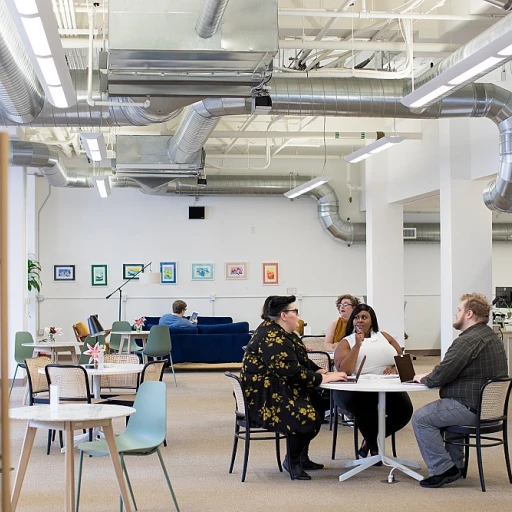
Understanding Diversity and Inclusion in Remote Teams
Fostering an Understanding of Diversity and Inclusion
The dynamics of remote teams are continuously evolving, embracing diversity and inclusion as essential pillars for meaningful collaboration. In a diverse and inclusive work environment, various elements such as cultural differences, diverse perspectives, and equity inclusion play a fundamental role. These elements are becoming increasingly significant as organizations aim to create workspaces where all team members feel valued and heard. When discussing diversity, it's important to acknowledge the wide range of backgrounds and experiences employees bring to the workplace. This includes differences in race, ethnicity, gender, age, and even professional expertise. Recognizing and embracing these differences can lead to a profound sense of belonging, resulting in higher employee engagement and commitment. An inclusive workplace is characterized by open communication and psychological safety, allowing team members to share ideas freely without fear of judgment. A truly inclusive environment enables individuals to participate fully in decision making, ensuring that diverse perspectives are incorporated into the organization's strategies. In light of these considerations, fostering diversity and inclusion in remote teams not only enhances collaboration but also strengthens the overall work culture. It's about creating a workplace where every employee feels respected and included in meaningful ways. For organizations striving to build a diverse and inclusive team, it's crucial to recognize the impact of unconscious bias and actively work towards mitigating its influence. Beyond these cultural aspects, the advent of global remote work has opened opportunities for hiring workers from diverse geographical locations, such as the benefits of hiring remote workers from Chile. By bringing together such a wide spectrum of cultural insights, organizations can enrich their team dynamics and foster an environment ripe for innovative thinking and growth.Challenges of Remote Collaboration in Diverse Teams
Addressing Cultural Differences and Unconscious Bias
Remote work has become an integral part of the modern workplace, bringing together diverse perspectives from team members across the globe. However, this diversity, while enriching, brings its own set of challenges to collaboration. One significant obstacle is the presence of cultural differences that can alter decision-making processes and affect team dynamics. Misunderstandings may arise when remote team members have different cultural interpretations of work environments. For instance, what might be considered direct and transparent communication in one culture could be perceived as confrontational in another. Addressing these differences openly is vital for fostering a work environment where every employee feels valued and heard. Furthermore, unconscious bias can hinder inclusive collaboration. Even well-intentioned individuals may unknowingly make assumptions based on stereotypes, impacting diversity equity and inclusion. Awareness and education are key to countering these biases, which can significantly impede employee engagement and the creation of an inclusive workplace.Overcoming Communication Barriers
Effective collaboration requires open communication, yet remote teams often face unique hurdles in this area. With team members working from different time zones, there can be challenges in maintaining real-time communication, which is crucial for decision making and fostering a sense of belonging. Clearly defining communication channels and protocols helps mitigate misunderstandings. Moreover, establishing a culture of psychological safety encourages team members to speak up without fear of judgment. This is particularly important in diverse teams where employees might feel hesitant to express their thoughts or concerns. Leaders and organizations must promote a culture that prioritizes equity and inclusion. This involves implementing structured yet flexible communication strategies that accommodate various working styles and preferences. This can bridge gaps, ensuring all voices are heard, and cultivating an inclusive environment. To explore further on creating diverse and inclusive remote teams, consider insights from the benefits of hiring remote workers from Chile.Strategies for Building Inclusive Remote Work Environments
Creating a Culture of inclusivity through proactive measures
Building an inclusive work environment in remote teams involves more than just assembling a group of diverse individuals. It requires a conscious effort from leadership to cultivate a culture that values diversity, promotes equity and fosters a sense of belonging among all team members. One crucial step is to ensure that organization leaders are committed to diversity inclusion as a fundamental aspect of the company culture. To effectively support an inclusive workplace, organizations must consider implementing proactive strategies that address unconsciously biased systems and practices. This involves:- Diversity and inclusion training: Regular training sessions help employees recognize and mitigate unconscious biases, enhancing their understanding of cultural differences and appreciation for diverse perspectives. By doing so, all team members can contribute to a more inclusive collaboration environment.
- Diverse representation in decision making: Encouraging diverse teams to take part in decision making processes allows for a broader range of viewpoints, enhancing innovation and creative problem solving. It’s essential to provide opportunities for teams to benefit from diverse perspectives that enrich overall workplace decision-making.
- Psychological safety and open communication: Creating an environment where employees feel safe voicing their ideas and concerns without fear of retaliation is paramount. Open communication channels enable team members to share experiences, fostering employee engagement and bridging cultural differences.
Leveraging Technology for Better Collaboration
Maximizing Collaboration Through Technology
The advent of technology has significantly bolstered collaboration in remote work settings, particularly within diverse and inclusive teams. Embracing digital tools designed to facilitate open communication can enhance understanding among team members from various cultural backgrounds. This is crucial in overcoming the challenges posed by cultural differences and unconscious bias, which can hinder effective collaboration. To create an inclusive environment, organizations should integrate platforms that promote real-time communication and transparency. Using tools such as instant messaging apps and video conferencing software ensures every team member feels involved in the conversation. It helps bridge cultural gaps by enabling diverse team members to connect more personally, fostering a sense of belonging and psychological safety. Task management and project collaboration software can also play a pivotal role in inclusive collaboration. These platforms help teams keep track of tasks, deadlines, and responsibilities, thus encouraging equitable participation among employees. This kind of engagement contributes to diversity equity and inclusion by democratizing decision making and ensuring every voice is heard. Moreover, leadership plays a critical role in leveraging technology to foster an inclusive workplace. Encouraging the use of digital collaboration tools helps break down barriers and allows for diverse perspectives in decision making. By making conscious efforts to incorporate diverse inclusive practices in digital meetings, leaders can set a precedent for employees to engage inclusively, paving the way for a cohesive and productive work culture. Ultimately, technology’s role in facilitating an inclusive work environment is indispensable. By effectively employing these tools, organizations can harness the full potential of diverse teams, enhancing both employee engagement and their overall success in a remote setting.Case Studies: Successful Diverse Remote Teams
Diverse Teams Achieving Collaborative Success
To witness the impactful outcomes of diverse teams and their collaborative efforts, examining real-world examples can illuminate how organizations nurture an inclusive work environment. These success stories often highlight how leadership plays a crucial role in integrating diverse perspectives into the workplace culture, thereby fostering a sense of belonging among team members.
One organization known for its inclusive workplace made impressive strides in decision making by ensuring all employees feel valued and heard. This involved establishing open communication channels that encouraged employees to express their cultural differences and diverse perspectives without fear of judgment or unconscious bias. As a result, the team experienced enhanced employee engagement and psychological safety, empowering them to excel in their respective roles.
In another instance, a company successfully integrated diversity equity and inclusion initiatives into their collaboration strategy by focusing on cultural differences and promoting an inclusive environment. By aligning their diversity inclusion goals with the organization’s overall mission, they effectively maximized the potential of each team member, resulting in innovative solutions and improved organizational performance.
These case studies underscore the importance of an inclusive collaboration mindset, where employees from diverse backgrounds contribute uniquely to a shared goal. When organizations prioritize equity inclusion in their collaborative efforts, it not only benefits the team but also creates a more harmonious and productive work environment, setting a precedent for future workplace trends.
Future Trends in Remote Work and Inclusion
Emerging Trends in Remote Work
The landscape of remote work is continually evolving, with diversity and inclusion at its core. Organizations are increasingly recognizing the value of diverse perspectives and inclusive environments, leading to innovative approaches in managing remote teams. Here are some trends shaping the future:
- Enhanced Use of Technology: Technology continues to be a driving force in facilitating inclusive collaboration. Tools that support open communication and decision-making are becoming more sophisticated, helping team members from diverse backgrounds work seamlessly together.
- Focus on Psychological Safety: Creating a work environment where employees feel safe to express their ideas is becoming a priority. Leadership is focusing on fostering a sense of belonging and addressing unconscious bias to ensure all team members feel valued.
- Flexible Work Policies: As organizations embrace remote work, flexible policies that cater to cultural differences and diverse needs are gaining traction. This flexibility is crucial in maintaining employee engagement and productivity.
- Emphasis on Diversity, Equity, and Inclusion (DEI): Companies are integrating DEI initiatives into their core strategies, recognizing that an inclusive workplace leads to better employee satisfaction and organizational success.
- Global Talent Pool Expansion: With remote work removing geographical barriers, organizations are tapping into a global talent pool, enhancing their teams with diverse skills and perspectives.
Future of Inclusive Remote Teams
The future of remote work is promising, with a strong emphasis on building inclusive workplaces. Organizations are investing in training programs to enhance cultural competence and open communication among team members. As remote work becomes more prevalent, the focus will be on creating environments that not only accommodate but celebrate diversity and inclusion.
By staying ahead of these trends, companies can ensure their remote teams are not only effective but also thriving in a diverse and inclusive work environment.












